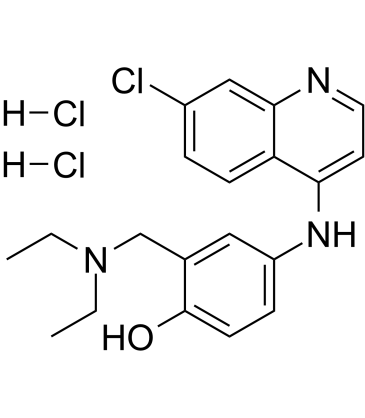Amodiaquine dihydrochloride |
| Catalog No.GC60579 |
Amodiaquine dihydrochloride (Amodiaquin dihydrochloride), a 4-aminoquinoline class of antimalarial agent, is a potent and orally active histamine N-methyltransferase inhibitor with a Ki of 18.6 nM.
Products are for research use only. Not for human use. We do not sell to patients.

Cas No.: 69-44-3
Sample solution is provided at 25 µL, 10mM.
Amodiaquine dihydrochloride (Amodiaquin dihydrochloride), a 4-aminoquinoline class of antimalarial agent, is a potent and orally active histamine N-methyltransferase inhibitor with a Ki of 18.6 nM. Amodiaquine dihydrochloride is also a Nurr1 agonist and specifically binds to Nurr1-LBD (ligand binding domain) with an EC50 of ~20 μM. Anti-inflammatory effect[1][2][3][4][5].
Amodiaquine (10-20 μM; 4 hours) treatment suppresses LPS-induced expression of proinflammatory cytokines (IL-1β, interleukin-6, TNF-α and iNOS) in a dose-dependent manner[1].Amodiaquine (5 μM; 24 hours) significantly inhibits neurotoxin (6-OHDA-induced cell death in primary dopamine cells as examined by the number of TH+ neurons and dopamine uptake. The neuroprotective effect of Amodiaquine is also observed in rat PC12 cells[1]. RT-PCR[1] Cell Line: Primary microglia
Amodiaquine (40 mg/kg; intraperitoneal injection; daily; for 3 days; male ICR mice) treatment diminishes perihematomal activation of microglia/macrophages and astrocytes. Amodiaquine also suppresses ICH-induced mRNA expression of IL-1β, CCL2 and CXCL2, and ameliorated motor dysfunction of mice[2]. Animal Model: Male ICR mice (8-10?weeks of age) induced ntracerebral hemorrhage (ICH)[2]
[1]. Chun-Hyung Kim, et al. Nuclear receptor Nurr1 agonists enhance its dual functions and improve behavioral deficits in an animal model of Parkinson's disease. Proc Natl Acad Sci U S A. 2015 Jul 14;112(28):8756-61. [2]. Keita Kinoshita, et al. A Nurr1 agonist amodiaquine attenuates inflammatory events and neurological deficits in a mouse model of intracerebral hemorrhage. J Neuroimmunol. 2019 May 15;330:48-54. [3]. Akira Yokoyama, et al. Effect of amodiaquine, a histamine N-methyltransferase inhibitor, on, Propionibacterium acnes and lipopolysaccharide-induced hepatitis in mice. Eur J Pharmacol. 2007 Mar 8;558(1-3):179-84. [4]. M T HOEKENGA. The treatment of acute malaria with single oral doses of amodiaquin, chloroquine, hydroxychloroquine and pyrimethamine. Am J Trop Med Hyg. 1954 Sep;3(5):833-8. [5]. John R Horton, et al. Structural basis for inhibition of histamine N-methyltransferase by diverse drugs. J Mol Biol. 2005 Oct 21;353(2):334-344.
Average Rating: 5 (Based on Reviews and 22 reference(s) in Google Scholar.)
GLPBIO products are for RESEARCH USE ONLY. Please make sure your review or question is research based.
Required fields are marked with *




















